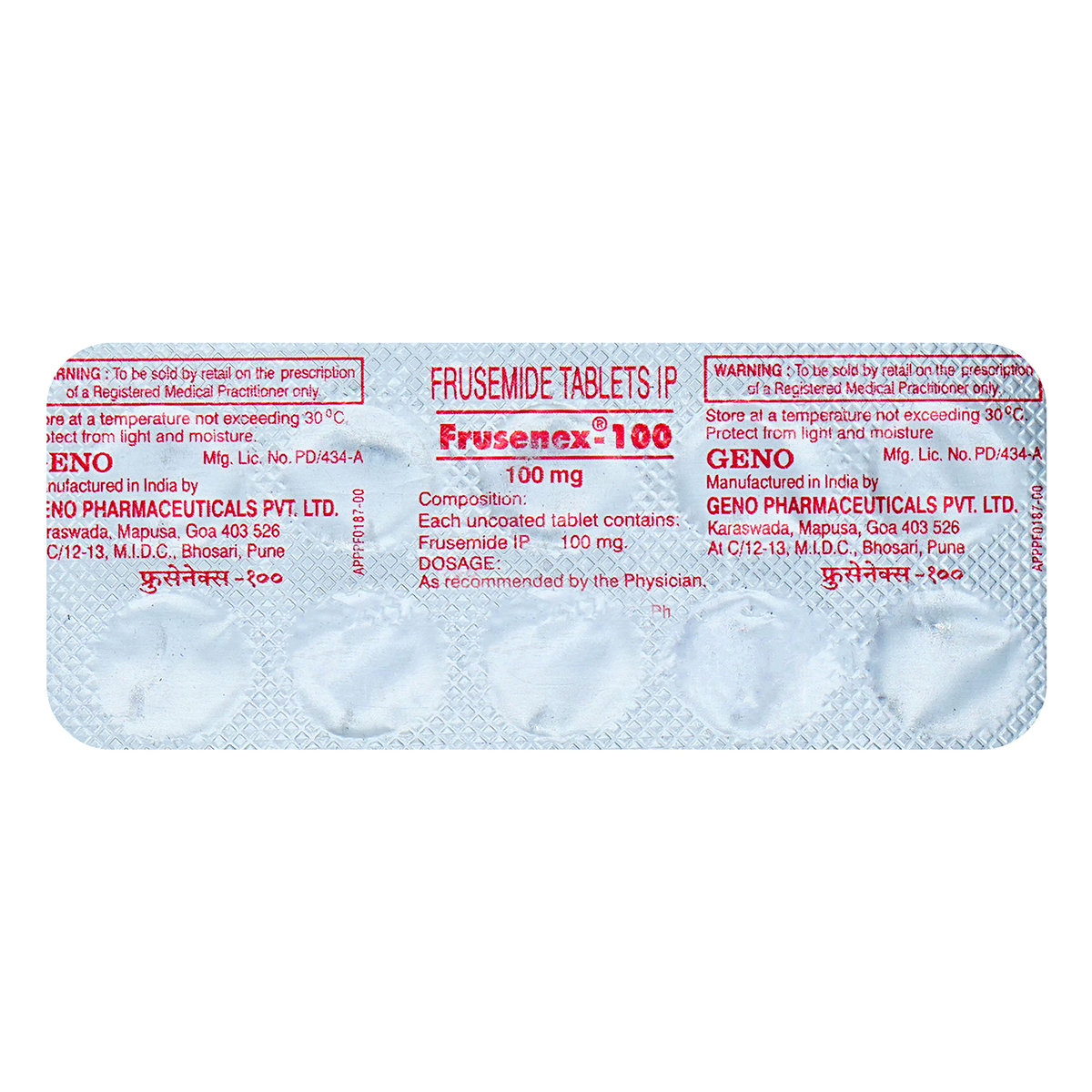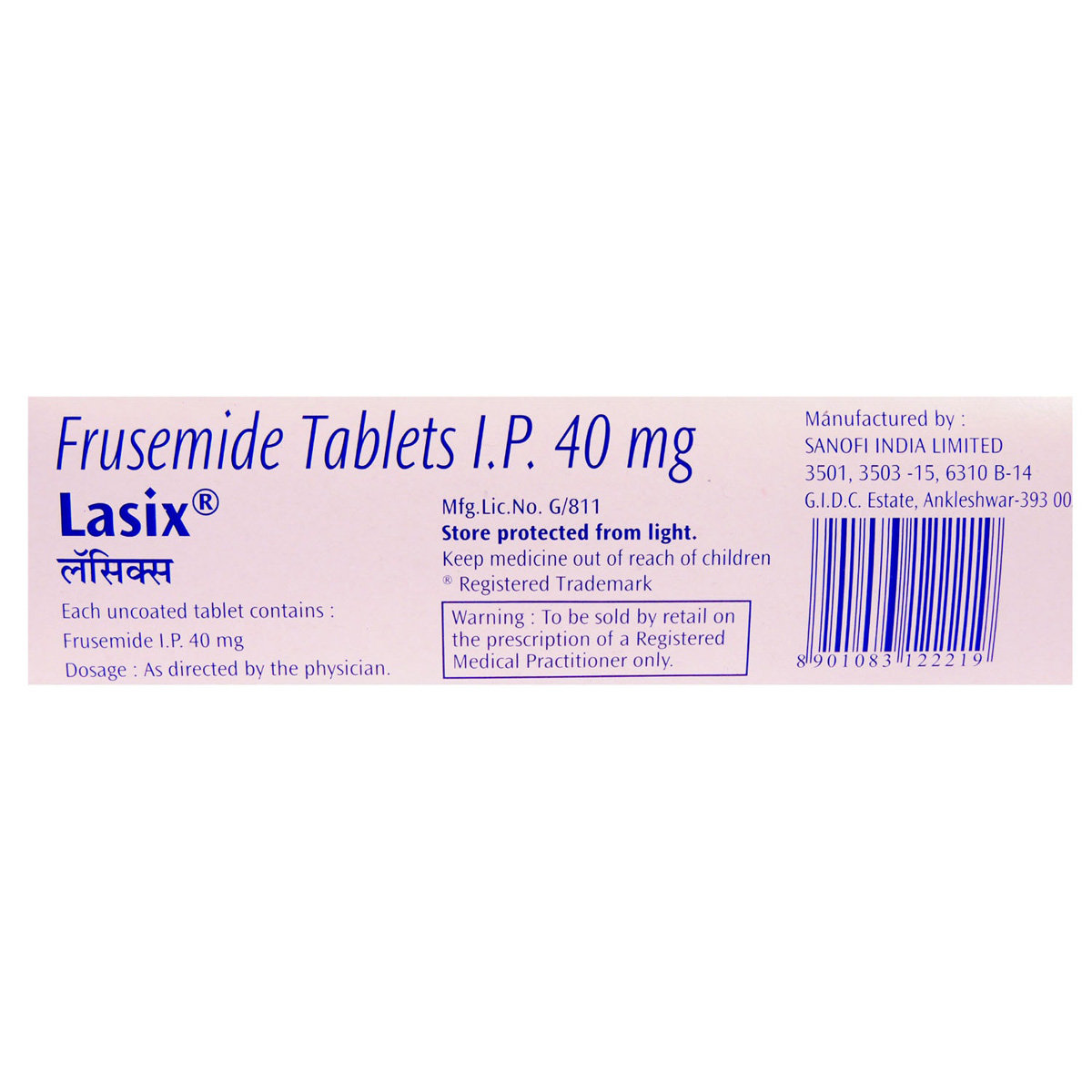Furosemide
About Furosemide
Furosemide belongs to a group of medicines called diuretics (which increase the production of urine) and is used to treat high blood pressure, heart failure, and oedema (a build-up of fluid in the body). Hypertension or high blood pressure is a chronic condition in which the force exerted by the blood against the artery wall is high. Higher this blood pressure, harder the heart has to pump. As a result, it leads to heart diseases, irregular heartbeat, and other complications. Oedema may occur in case of high blood pressure where fluids of the body get trapped in the tissues of the hands, arms, feet, ankles, and legs leading to its swelling.
Furosemide works by increasing the amount of urine that is passed out from the kidneys. It effectively reduces excess fluid levels in the body and treats oedema (swelling) associated with heart, liver, kidney, or lung disease. This reduces the workload on the heart and makes the heart more efficient at pumping blood throughout the body. Thus, it helps to lower high blood pressure, reducing the chances of heart attack or stroke.
Your doctor will advise your dose and how often you need to take this medication based on your medical condition. In some cases, you may experience dehydration, headache, nausea, or dizziness. Most of these side effects of Furosemide do not require medical attention and gradually resolve over time. However, if the side effects are persistent, reach out to your doctor.
Do not take if you are allergic to furosemide or any other components present in Furosemide. Try not to stop taking Furosemide of your own. Let your doctor know about this, as it may cause a rise in blood pressure and can increase the risk of getting heart diseases and stroke. Inform your doctor if you are suffering from any kidney or liver or heart disease. If you are pregnant or breastfeeding, please tell your doctor so that the dosage of Furosemide can be prescribed accordingly. The most common adverse effect of furosemide is having to pee more frequently than usual. To minimise needing to get out of bed to pee, avoid taking this medication within 4 hours of going to bed.
Uses of Furosemide
Medicinal Benefits
When you take Furosemide, the blood vessels in your body will be relaxed, which will help lower the blood pressure. Also, it relaxes the blood vessels and helps to improve the blood flow. It helps in losing out excess fluids from the body by increasing the production of urine. This reduces the workload on the heart and makes the heart more efficient at pumping blood throughout the body. Thus, it helps to lower high blood pressure, reducing the chances of heart attack or stroke. In addition, this relieves oedema and enables you to carry out your daily activities more efficiently.
Directions for Use
Storage
Side Effects of Furosemide
- Frequent urination
- Hypotension (low blood pressure)
- Dehydration
- Headache
- Somnolence (sleepiness)
- Fatigue
- Reduced levels of potassium and magnesium in your blood
Drug Warnings
To ensure that furosemide is safe for you, tell your doctor if you have ever had an allergic reaction to furosemide or any other medicine, low blood pressure (hypotension), liver disease, diabetes, any difficulty peeing, Addison's disease (a rare disorder of the adrenal glands), gout, and signs of dehydration (being thirsty, having a dry mouth), and electrolyte imbalance, among other things. If you are a pregnant or nursing mother, you should not take Furosemide without a doctor's advice.
Drug Interactions
Drug-Drug Interactions: Furosemide may interact with other high blood pressure-lowering pills (e.g. metoprolol, ramipril, hydrochlorothiazide, atorvastatin) and can lower your blood pressure leading to severe condition. Besides this, it also interacts with medicine to treat erectile dysfunction (e.g. sildenafil), anti-epilepsy medicines (e.g. carbamazepine, phenobarbital), immune-suppressing drugs (e.g. cyclosporine), and painkillers (e.g. ibuprofen, aspirin), and medications used to treat irregular heartbeats (e.g. sotalol). If you are taking any of the above, speak with your doctor.
Drug-Food Interactions: You are recommended not to consume alcohol with Furosemide to avoid unpleasant side effects.
Drug-Disease Interactions: Furosemide may interact with disease conditions, including ototoxicity (hearing loss), electrolyte abnormalities, anuria (patients with nil urine output), low blood pressure, Gout (a type of arthritis) and diabetics, and Addison's disease (adrenal gland disorder).
Drug-Drug Interactions Checker List:
Safety Advice

Alcohol
cautionYou are recommended not to consume alcohol along with Furosemide to avoid unpleasant side-effects.

Pregnancy
cautionFurosemide should not be used during pregnancy unless clearly necessary. Your doctor will weigh the benefits and any potential risks before prescribing it to you. Please consult your doctor.

Breast Feeding
cautionFurosemide should not be used when breastfeeding unless clearly necessary. Your doctor will weigh the benefits and any potential risks before prescribing it to you. Please consult your doctor.

Driving
unsafeIt is not recommended to drive after taking Furosemide as it may occasionally cause drowsiness.

Liver
cautionFurosemide to be taken with caution, especially if you have a history of liver diseases/conditions. Your doctor may adjust your dose depending upon your current liver conditions.

Kidney
cautionFurosemide to be taken with caution, especially if you have a history of Kidney diseases/conditions. Your doctor may adjust your dose depending upon your current kidney conditions.

Children
cautionFurosemide to be taken with caution, especially if you are children below the age of 12. Your doctor may adjust your dose depending upon your age.
Habit Forming
Diet & Lifestyle Advise
- Keep your weight under control with a BMI of 19.5-24.9.
- Regular physical activity or exercise for at least 150 minutes per week, or about 30 minutes most days of the week. Doing this can help lower your raised blood pressure by about 5 mm Hg.
- Opt for a diet rich in whole grains, fruits, veggies, and low-fat dairy products.
- Limit sodium chloride (table salt) intake in your daily diet to 2300 mg per day or less than 1500 mg is ideal for most adults.
- If you are taking alcohol, then only one serving for women and two for men is advisable.
- Quitting smoking is the best strategy to lower the risk of heart disease.
- Avoid chronic stress as it can raise your blood pressure. Try to enjoy and spend time with your loved ones to cope with stress and practice mindfulness techniques.
- Try to include heart-healthy omega-3 fatty acids containing food drinks in your daily diet. You can also use low-fat cooking oil like olive oil, soybean oil, canola oil, and coconut oil to help lower your elevated blood pressure.
Special Advise
- Monitor your blood pressure daily and if there is too much fluctuation, immediately contact your doctor.
- If you are planning to have a procedure that includes radiocontrast, do not take Furosemide (as taking Furosemide may increase the risk of kidney damage).
Patients Concern
Disease/Condition Glossary
Hypertension: It is a chronic condition when blood pressure is too high. This condition can lead to hardened arteries (blood vessels), decreasing the blood and oxygen flow to the heart. Blood pressure is the measurement of the force that our heart uses to pump blood to all parts of the body. Raised blood pressure can cause chest pain (angina) and heart attack (when blood supply to the heart is blocked). Additionally, high blood pressure also causes brain damage (stroke) and kidney failure. High blood pressure can be diagnosed with the help of a blood pressure monitor or sphygmomanometer. Systolic pressure is the pressure when the heart pumps blood out. On the other hand, diastolic pressure is the pressure when your heart is at the resting stage between heartbeats. If your blood pressure is 140/90 mm of Hg, it means the systolic pressure is 140 mm of Hg, and diastolic pressure is 90 mm of Hg. Ideal blood pressure is around 120/80 mm of Hg.
Oedema: Swelling in the body parts such as ankles, feet and legs is often caused by a build-up of fluid in these areas, called oedema.
FAQs
Furosemide belongs to a class of drugs known as diuretics, which increase urine production to eliminate excess water (fluid retention) in the body. This indicates there is less fluid in your tissues, which helps with swelling reduction (oedema). You will also have less fluid in your blood circulation, which will help to lower your blood pressure.
Your symptoms may improve before the problem is completely cured. But, it would be suggested to complete the full course of treatment even if you feel better.
Yes, Furosemide is contraindicated in people with known allergy to any of the components of Furosemide. It should be avoided in people with severe kidney or liver impairment and in people with anuria (reduction or absence of urine).
No, you are advised to inform your doctor and monitor your blood pressure for at least two weeks before stopping the medicine. Depending upon your current blood pressure readings, there is a possibility your doctor may lower your medicine dosage and not recommend to discontinue it.
Furosemide can be safely taken as long as your doctor has prescribed it to you. Conditions such as high blood pressure are life-long conditions and one should not abruptly discontinue it without discussing it with a doctor.
No, the occurrence of gout due to Furosemide is very rare. However, it can cause an increase in the levels of uric acid.
There's no evidence that Furosemide reduces fertility in men or women. However, if you're a woman and you're trying to get pregnant, talk to your doctor first.
A good rule is to drink enough fluid so that you're not thirsty for long periods.








